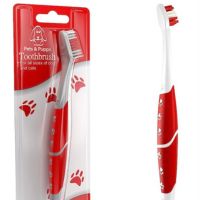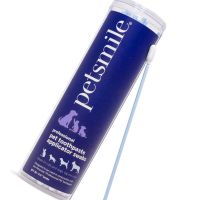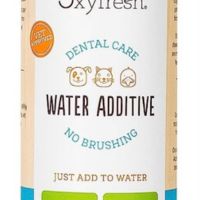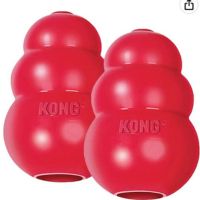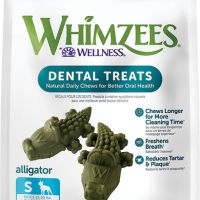How to Clean Dog Teeth: Your Most Common Questions
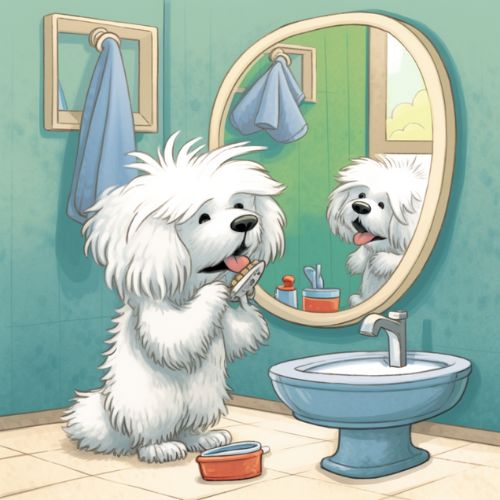
Learning how to clean dog teeth is a game-changer when it comes to your dog’s overall health and well-being. But it can be a little overwhelming if you don’t have the right tools and techniques. So, let’s dive into the world of dog teeth cleaning to make it easier (for you and your dog).
Just like humans, dogs can suffer from dental problems such as gum disease and tooth decay. Neglecting your dog's dental hygiene can lead to painful infections and costly vet bills. Fortunately, there are several ways to keep your dog's teeth clean and healthy.
One of the most effective ways to clean your dog's teeth is through regular brushing. You can use a specialized dog toothbrush and toothpaste to remove plaque and tartar buildup.
It's important to start slowly and make the experience positive for your dog by offering treats and praise. In addition to brushing, you can also provide dental chews and toys that help scrape away debris and promote healthy teeth and gums. See the recommendations below. By incorporating these habits into your dog's routine, you can help prevent dental problems and keep your furry friend's smile shining bright.
Most Common Questions about How to Clean Dog Teeth
As a new pet parent, I had so many questions about how to clean dog teeth because I wasn’t sure about the logistics and techniques. Below are some of the tips I’ve learned over the years to make things easier on both me and my dogs.
Here are the answers to the most frequently asked questions about maintaining your dog's dental hygiene. Let's demystify the process of keeping those cute little teeth clean and healthy!
Why Clean Your Dog's Teeth?
Just like humans, dogs can develop dental problems if their teeth are not properly cared for.
Here are a few reasons why you should make sure your dog's teeth are clean:
- Prevent Dental Disease: Dogs can develop dental diseases such as gingivitis, periodontitis, and tooth decay just like humans. These conditions can cause pain, difficulty eating, and even lead to other health problems such as infections. By keeping your dog's teeth clean, you can prevent these issues from occurring.
- Freshen Breath: Bad breath is a common problem in dogs, and it's often caused by a buildup of bacteria in their mouths. By regularly cleaning your dog's teeth, you can help reduce the amount of bacteria in their mouth and freshen their breath.
- Save Money: Dental procedures can be expensive, especially if your dog needs to have teeth extracted or undergo other treatments. By keeping your dog's teeth clean, you can help prevent the need for these procedures and save money in the long run.
- Improve Overall Health: Dental problems can lead to other health issues in dogs, such as infections in the heart, liver, and kidneys. By keeping your dog's teeth clean, you can help improve their overall health and well-being.
How often should I brush my dog's teeth?
You should aim to brush your dog's teeth at least two to three times a week, but ideally, you should brush them every day. This will help prevent the buildup of plaque and tartar on their teeth, which can lead to dental problems such as gum disease, tooth decay, and bad breath.
How to brush dog teeth?
This is a cute video on how to brush your dog’s teeth. I love how the Coton de Tulear tries to delay the inevitable.
What kind of toothpaste should I use for my dog?
You should use a toothpaste specifically designed for dogs. Human toothpaste is not safe for dogs, as it contains ingredients that can be harmful if ingested, such as xylitol, fluoride, and baking soda.
Dog toothpaste should be formulated with ingredients that are safe for dogs to ingest and come in flavors that dogs enjoy, such as chicken, beef, or peanut butter. Some dog toothpastes also contain enzymes that help break down plaque and tartar on the teeth.
When choosing a toothpaste for your dog, make sure to read the label and choose a product that is approved by the Veterinary Oral Health Council (VOHC). The VOHC is an organization that evaluates dental products for pets and provides a seal of approval for products that meet their standards.
If you have any questions or concerns about choosing a toothpaste for your dog, consult with your veterinarian for advice.
Is brushing a dog's teeth with coconut oil a good idea?
Brushing a dog's teeth with coconut oil can be a good idea because it has anti-inflammatory and anti-bacterial properties that can help improve oral health. Coconut oil contains lauric acid, which can help reduce the amount of bacteria in the mouth and prevent plaque buildup on the teeth. Additionally, the oil can help freshen a dog's breath.
To brush a dog's teeth with coconut oil, you can use a soft-bristled toothbrush or a finger brush. Simply dip the brush into melted coconut oil and brush your dog's teeth in a circular motion. You can also let your dog lick the coconut oil off the brush to help freshen their breath.
However, it's important to note that brushing with coconut oil alone may not be enough to maintain good oral health. It's still recommended to brush a dog's teeth regularly with a dog-specific toothpaste and to take them for regular dental checkups with a veterinarian.
What if my dog won’t let me brush his teeth? How do I introduce teeth brushing to my dog?
Introducing teeth brushing to your dog may take some patience and training, but the following steps can help make the process easier:
- Start slowly: Begin by getting your dog used to having your fingers in his mouth. Gently rub your fingers along his gums and teeth for a few seconds at a time.
- Choose a quiet, comfortable location: Find a quiet, comfortable location where you and your dog can relax and focus on the task at hand.
- Use a flavored toothpaste: Dogs may be more willing to have their teeth brushed if the toothpaste tastes good to them. Try using a flavored toothpaste designed for dogs.
- Let your dog smell and taste the toothpaste: Before brushing, let your dog smell and taste the toothpaste. This can help them become more comfortable with the taste and texture.
- Use a soft-bristled toothbrush or finger brush: Use a soft-bristled toothbrush or a finger brush designed for dogs. Gently brush your dog's teeth in a circular motion, focusing on the gumline.
- Use a different tool: If your dog doesn't like having a toothbrush in his mouth, try using a finger brush or a piece of gauze wrapped around your finger instead.
- Make it a positive experience: Offer your dog lots of praise and treats during and after the teeth-brushing session to make it a positive experience.
- Increase the duration gradually: Gradually increase the duration of the teeth-brushing sessions over time. Start with just a few seconds and work up to a minute or two.
- Choose an alternative method for teeth cleaning: Check out some of the options below for dogs like Lucy who becomes too stressful with the toothbrushing,
- Consider professional cleanings: If your dog still won't let you brush his teeth, consider taking him to a professional groomer or veterinarian for a dental cleaning.
Remember, it's important to be patient and consistent when introducing teeth brushing to your dog. If your dog is resistant, try to make the experience more enjoyable by offering treats and praise. If you're having difficulty, consult with your veterinarian for advice.
Are there any other methods to clean my dog's teeth besides brushing?
Lucy used to be pretty cool with getting her teeth brushed, but things took a turn when seizures entered the picture. Now, she's not having any of it when it comes to the toothbrush. That's why I've had to get creative and experiment with a bunch of alternative options from the list below. It's all about minimizing her stress and finding what works best for her now!
- Dental chews: There are many types of dental chews that are designed to help clean a dog's teeth. These dog treats that clean teeth are made with ingredients that help remove plaque and tartar buildup. Whimsies is one of Lucy’s favorites.
- Dog water additives and dental sprays: There are additives that can be added to a dog's drinking water to help freshen breath and reduce plaque and tartar buildup.Water additives typically contain enzymes or other ingredients that help to break down plaque and tartar on the teeth. There are many products available to choose from, however, they are not as effective as brushing your dog's teeth or having them professionally cleaned by a veterinarian. Dental sprays are designed to be sprayed directly onto a dog's teeth and gums, and are a good way to supplement your pet’s teeth cleaning. They can help reduce plaque and tartar buildup and freshen breath, but like water additives, they are not a substitute for regular dental care. Watch out for products with baking soda (see question below).
- Raw bones can help clean a dog's teeth naturally. The chewing action helps to scrape away plaque and tartar buildup. Raw bones can be effective for teeth cleaning in dogs, but they are not without risks. There is a risk of your dog breaking a tooth or choking on a bone fragment, especially if the bone is too small or brittle. Additionally, raw bones can carry bacteria that can be harmful to your dog, and they can also cause digestive issues if ingested in large quantities. It's important to supervise them closely and choose bones that are appropriate for their size and chewing habits. Raw bones should always be given under supervision and taken away once they become small enough to be swallowed whole. It's also important to make sure that the bones are from a reputable source and have been properly cleaned and prepared to reduce the risk of bacterial contamination.
- Dental wipes can be a good option to clean a dog's teeth, especially if the dog is resistant to having their teeth brushed with a toothbrush. Dental wipes are designed to be rubbed along the teeth and gums to help remove plaque and tartar buildup.However, it's important to note that dental wipes may not be as effective as brushing with a toothbrush. The mechanical action of brushing helps to remove plaque and tartar buildup more effectively than just rubbing with a wipe. Additionally, dental wipes may not be able to reach all areas of the mouth as effectively as a toothbrush.
- Finger Toothbrush: This is what I use for Lucy. While she doesn’t love this toothbrush substitute, she will allow it - mostly because she knows that she gets a treat at the end.
- Dental chew toys can help reduce tartar and plaque and are also fun for strong chewers. There are rubber chew toys like Kong, antlers and horns, and rope toys. Experiment to see which works best for your dog.
It's important to note that while these methods can help keep a dog's teeth clean, they are not a substitute for regular brushing. It's still recommended to brush a dog's teeth regularly to maintain good oral health.
Can I use human toothpaste on my dog?
No, dogs should not use human toothpaste. Human toothpaste contains ingredients that can be harmful to dogs and can cause digestive upset, vomiting, and diarrhea.
Additionally, human toothpaste is not designed to be swallowed, and dogs are not able to spit out the toothpaste like humans can. This means that if they ingest the toothpaste, it can be harmful to their health.
Instead, it's recommended to use a toothpaste specifically designed for dogs. These toothpastes are formulated with ingredients that are safe for dogs to ingest.
Can I use baking soda to clean my dog's teeth?
It's not recommended to clean a dog's teeth with baking soda. While baking soda can help remove surface stains on teeth and has some anti-bacterial properties, it can be abrasive and may damage the enamel on a dog's teeth. Additionally, baking soda is not designed to be ingested, and if a dog swallows too much of it, it can cause digestive upset.
Instead of using baking soda, it's recommended to use a toothpaste specifically designed for dogs.

What are the signs of dental problems in dogs?
It's important to keep an eye out for signs of dental problems in your which can lead to pain, discomfort, and even serious health problems if left untreated. Here are some common signs to watch out for:
- Bad Breath: While it's normal for dogs to have some level of bad breath, if it's consistently foul or noticeably worse than usual, it could be a sign of dental problems.
- Yellow or Brown Teeth: Discoloration of the teeth can be a sign of tartar buildup, which can lead to gum disease and tooth decay.
- Bleeding or Swollen Gums: Healthy gums should be pink and firm. If you notice bleeding, redness, or swelling, it could be a sign of gingivitis or periodontal disease.
- Difficulty Eating: If your dog is having trouble chewing or seems to be in pain while eating, it could be due to dental issues.
- Pawing at the Mouth: Dogs may paw at their mouth or face if they are experiencing pain or discomfort in their teeth or gums.
If you notice any of these signs, it's important to take your dog to the vet for a dental checkup. Regular dental cleanings and at-home dental care can help prevent dental problems and keep your dog's teeth healthy and strong.
Should I take my dog to the vet for a dental cleaning?
Yes, it's a good idea to take your dog to the veterinarian for a dental cleaning. Regular dental cleanings can help prevent dental problems, such as gum disease, tooth decay, and bad breath. During a dental cleaning, the veterinarian will remove any plaque and tartar buildup on your dog's teeth and examine their mouth for any signs of dental problems.
If your dog has severe dental problems, such as gingivitis or periodontal disease, they may require more extensive dental treatment, such as tooth extractions or gum surgery. Your veterinarian can provide you with advice on the best course of treatment for your dog's specific dental needs.
It's important to note that dental cleanings require general anesthesia, which can be risky for older dogs or dogs with certain health conditions. Your veterinarian will evaluate your dog's health before recommending a dental cleaning and will take steps to minimize any risks.
Regular dental cleanings, along with a good dental care routine at home, can help keep your dog's teeth and gums healthy and prevent dental problems. If you have any questions or concerns about your dog's dental health, consult with your veterinarian for advice.

Brushing your dog's teeth regularly can also help you detect any dental problems early on, such as broken teeth, swollen gums, or signs of infection. If you notice any of these issues, it's important to take your dog to the veterinarian as soon as possible.
If you're having difficulty brushing your dog's teeth, try to make it a positive experience by offering treats and praise. You can also try using some of the above alternatives to tooth brushing, which can make the experience more enjoyable for them.
Home | About Me | Contact Me | Privacy Policy |Disclosure
Copyright© 2008- All Rights Reserved


